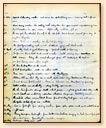|

|
THE
NATURALIST
 Influenced
by her grandmother, Frederica Cooke's, love of plants Rica
displayed an early interest in the local flora and fauna,
and as a Girl Guide in Boulder gained her naturalist badge.
Later, at Kendenup, her fascination with botany was sparked
by the work of Emily Pelloe on Western Australian wildflowers
when C.J. de Garis, who was the publisher of Pelloe's books,
gave Rica's family a copy as a Christmas present. In West
Australian Orchids Pelloe mentioned that Dr R.S. Rogers
of Adelaide, the leading orchid specialist in Australia at
that time, was searching for information on a particular orchid.
Believing she had found the orchid, Rica sent him a specimen
to which he responded with an excited telegram. Influenced
by her grandmother, Frederica Cooke's, love of plants Rica
displayed an early interest in the local flora and fauna,
and as a Girl Guide in Boulder gained her naturalist badge.
Later, at Kendenup, her fascination with botany was sparked
by the work of Emily Pelloe on Western Australian wildflowers
when C.J. de Garis, who was the publisher of Pelloe's books,
gave Rica's family a copy as a Christmas present. In West
Australian Orchids Pelloe mentioned that Dr R.S. Rogers
of Adelaide, the leading orchid specialist in Australia at
that time, was searching for information on a particular orchid.
Believing she had found the orchid, Rica sent him a specimen
to which he responded with an excited telegram.
While
at Claremont Teachers' College she was inspired by two very
good teachers, Charles Hamilton the art instructor and Dr
Millington who was in charge of the nature study series. It
was while teaching she started keeping nature diaries with
the hope of using the research on orchids to gain a further
certificate in teaching.
   
 Rica
joined the Western Australian Naturalists' Club in 1932 and
followed her passion for anything to do with nature: birds,
flowers and insects. Though isolated as a country schoolteacher
she was able to spend her free time studying the wonders of
the bush. As her enthusiasm grew so did her contacts both
in Western Australia and interstate. Through her long-term
correspondence with experts she was able to provide them with
specimens and develop her skills as a naturalist. Rica
joined the Western Australian Naturalists' Club in 1932 and
followed her passion for anything to do with nature: birds,
flowers and insects. Though isolated as a country schoolteacher
she was able to spend her free time studying the wonders of
the bush. As her enthusiasm grew so did her contacts both
in Western Australia and interstate. Through her long-term
correspondence with experts she was able to provide them with
specimens and develop her skills as a naturalist.
 Dr
Rogers taught Rica how to make sectional drawings of the flowers
as required by scientists and the botanical classification
of flora. She started to write and collect specimens for other
orchid experts including Edith Coleman of Melbourne and Rev.
H.M.R. Rupp in NSW. Louis Glauert, the curator of the Western
Australian Museum, and Frederick Rowe, a renowned local naturalist
and botanist, were added to the list. With the help of Dom
Serventy, Western Australia's leading ornithologist, she obtained
a secondhand microscope for plant dissections. Dr
Rogers taught Rica how to make sectional drawings of the flowers
as required by scientists and the botanical classification
of flora. She started to write and collect specimens for other
orchid experts including Edith Coleman of Melbourne and Rev.
H.M.R. Rupp in NSW. Louis Glauert, the curator of the Western
Australian Museum, and Frederick Rowe, a renowned local naturalist
and botanist, were added to the list. With the help of Dom
Serventy, Western Australia's leading ornithologist, she obtained
a secondhand microscope for plant dissections.
As a young mother in Bolgart, Rica's interests included the
study of the life history of the rufous whistler, a bird that
stays in the same territory year round. She became fascinated
by native bees and wasps, and studied them in conjunction
with the hymenoptera expert Tarlton Rayment who honoured Rica
by naming bees after her, her daughter Dorothy and her husband
Syd.
At the
same time I was reciprocating you see for Tarlton Rayment;
I was catching every bee that I could find in the bush.
I had my own method - he told me how to make a net but I
could never use a net. I used to go out with a piece of
cardboard and a glass, an ordinary tumbler, and I'd watch
the insect land and you just clap one on the other and then
you'd put the glass over the top of your killing bottle
which Tarlton told me how to make. I hated killing them
but I had to send him specimens because he was so good to
me. I'd put the glass over the mouth of the bottle and draw
the cardboard away and they flutter down into the killing
bottle and that's it. He taught me how to fold them up and
to send them over to him and all the rest. I had a little
daughter of six at the time - perhaps she'd be younger -
that's Dorothy and it was before she was six - and she caught
bees for him too, following the same method. He named one
after her once. He named one after me. (Battye Library,
OH 2528, p. 5)
|
